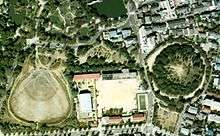Hachimanyama Kofun (Nagoya)
The Hachimanyama Kofun (八幡山古墳, Hachimanyama Kofun) is an archaeological site containing a large Kofun period [[kofun|burial mound] located in what is now part of Shōwa Ward in the city of Nagoya, Aichi Prefecture. Dating from the mid-fifth century, it is the largest circular kofun in the Tōkai region of Japan. The site was designated as a National Historic Site by the Japanese government in 1931. [1]
八幡山古墳 | |
 Hachimanyama Kofun | |
 Hachimanyama Kofun  Hachimanyama Kofun (Nagoya) (Japan) | |
| Location | Shōwa-ku, Nagoya, Japan |
|---|---|
| Region | Tōkai region |
| Coordinates | 35°09′14″N 136°55′26″E |
| History | |
| Periods | Kofun period |
| Site notes | |
| Ownership | National Historic Site |
| Public access | No |
Overview
The Hachimanyama Kofun is a large circular mound, with a diameter of 82 meters and height of 10 meters, and was once surrounded by a 10-meter wide moat (now filled in). The name "Hachimanyama" came from a Shinto shrine, the Hachiman Jinja, which was once located on its summit. The kofun is the largest and only survivor of a group of tumuli which once existed in the area. It was incorporated into Tsurumai Park in 1919. During World War II, the site was seized by the Imperial Japanese Army, and the summit was flattened for use as the location of an anti-aircraft battery. After the war, the mound was remodeled by the city of Nagoya, and trees were replanted; however, no excavation was made and the site was fenced off with public access prohibited. Per pre-war records, numerous haniwa had been recovered from the site, but these were lost in the war and their present whereabouts (or even if they still survive) is unknown.
The kofun is located about 8 minutes on foot from JR Chuo Main Line Tsurumai Station.
References
- "八幡山古墳" (in Japanese). Agency for Cultural Affairs.
External links
| Wikimedia Commons has media related to Hachimanyama kofun (Aichi). |
- Nagoya Showa-ku Area Guiide (in Japanese)
- Aichi Tourist Information Guide (in Japanese)